词汇学第三章Morphological structure of English words ppt
- 格式:ppt
- 大小:467.50 KB
- 文档页数:27
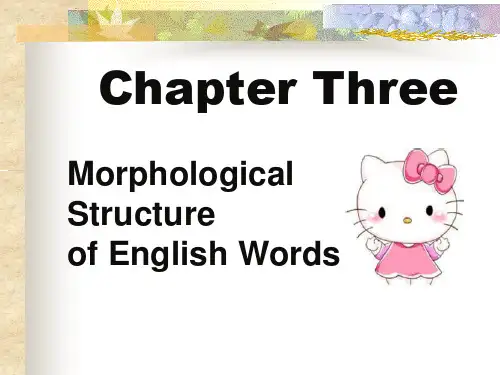
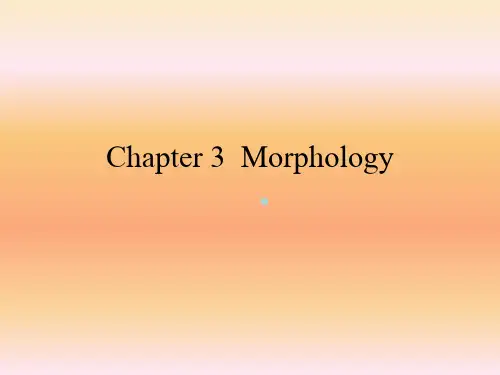
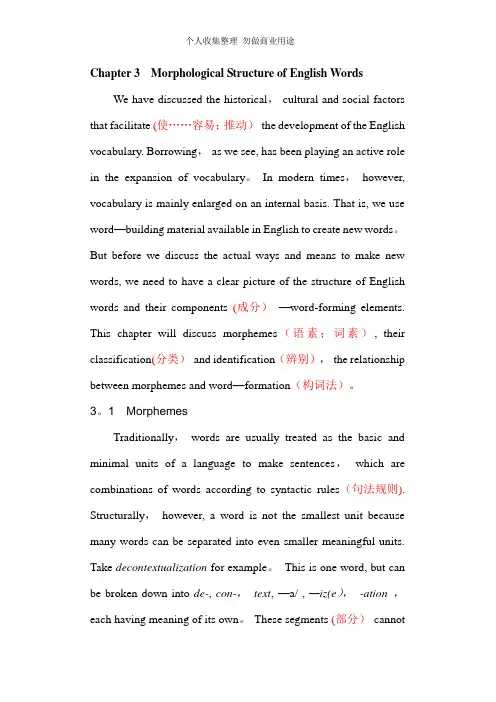
Chapter 3 Morphological Structure of English Words We have discussed the historical, cultural and social factors that facilitate (使……容易;推动)the development of the English vocabulary. Borrowing, as we see, has been playing an active role in the expansion of vocabulary。
In modern times,however, vocabulary is mainly enlarged on an internal basis. That is, we use word—building material available in English to create new words。
But before we discuss the actual ways and means to make new words, we need to have a clear picture of the structure of English words and their components (成分)—word-forming elements. This chapter will discuss morphemes(语素;词素), their classification(分类)and identification(辨别), the relationship between morphemes and word—formation(构词法)。
3。
1 MorphemesTraditionally,words are usually treated as the basic and minimal units of a language to make sentences,which are combinations of words according to syntactic rules(句法规则). Structurally,however, a word is not the smallest unit because many words can be separated into even smaller meaningful units. Take decontextualization for example。
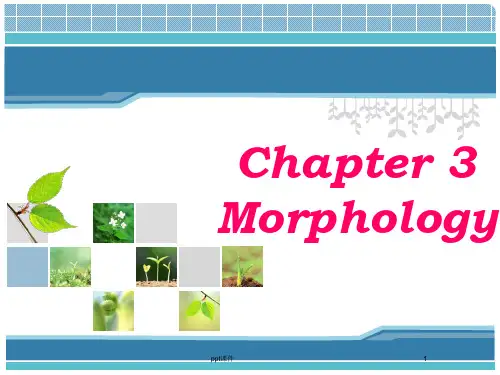
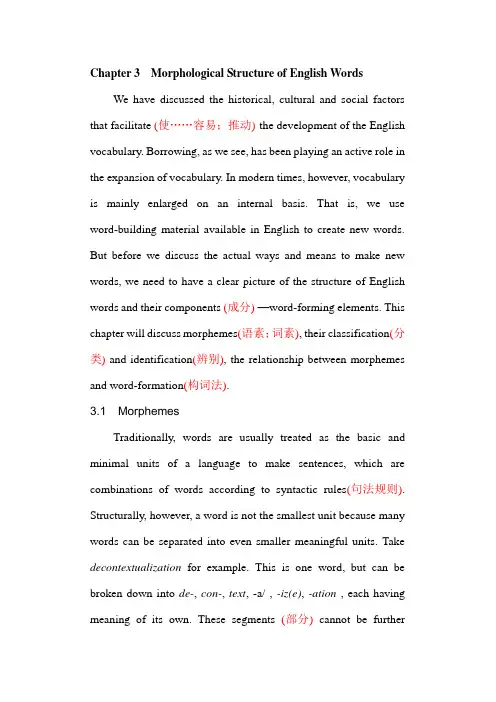
Chapter 3 Morphological Structure of English Words We have discussed the historical, cultural and social factors that facilitate (使……容易;推动) the development of the English vocabulary. Borrowing, as we see, has been playing an active role in the expansion of vocabulary. In modern times, however, vocabulary is mainly enlarged on an internal basis. That is, we use word-building material available in English to create new words. But before we discuss the actual ways and means to make new words, we need to have a clear picture of the structure of English words and their components (成分) —word-forming elements. This chapter will discuss morphemes(语素;词素), their classification(分类) and identification(辨别), the relationship between morphemes and word-formation(构词法).3.1 MorphemesTraditionally, words are usually treated as the basic and minimal units of a language to make sentences, which are combinations of words according to syntactic rules(句法规则). Structurally, however, a word is not the smallest unit because many words can be separated into even smaller meaningful units. Take decontextualization for example. This is one word, but can be broken down into de-, con-, text, -a/ , -iz(e), -ation , each having meaning of its own. These segments (部分) cannot be furtherdivided; otherwise, none of them would make any sense. Though -ation has a number of variants (变体) such as -tion, -sion, -ion, they belong to the same suffix as they have the same meaning and grammatical function and occur owing to (因为;根据) different sound environment. These minimal meaningful units are known as morphemes (morphe is the Greek word for 'form'; -eme as in 'phoneme' (音素) means 'class of' ). In view of word-formation, the morpheme is seen as 'the smallest functioning unit in the composition of words' (Crystal 1985). Syntactically(从句法上看), however, a morpheme is the minimal form of grammatical analysis (语法分析). For instance, each of the word-forms studies, studying, studied, consists of the morpheme study + ; the forms -es in studies, -ing in studying, -ed in studied are morphemes, which express grammatical concepts (语法概念) instead of deriving new words (See Classifying Morphemes).3.2 Morphs and Allomorphs(词素变体)Morphemes are abstract units, which are realized in speech by discrete units (具体单位) known as morphs(形素). 'They are actual spoken, minimal carriers of meaning' (Bolinger and Sears 1981:43). In other words the phonetic or orthographic strings(语音串或拼写字串)or segments (切分成分;节) which realize morphemes are termed 'morphs' (Bauer 1983:15). The morpheme isto the morph what a phoneme (音位) is to a phone (音素). Most morphemes are realized by single morphs like bird, tree, green , sad, want, desire, etc. . These morphemes coincide (巧合) with words as they can stand by themselves and function freely in a sentence. Words of this kind are called mono-morphemic words. Some morphemes, however, are realized by more than one morph according to their position in a word. For instance, the morpheme of plurality {-s} has a set of morphs in different sound context, e. g. in cats /s/, in bags /z/, in matches /iz/. The alternates (作为替换的事物) /s/, /z/ and /iz/ are three different morphs. The same is true of the link verb morpheme {be}. Its past tense is realized by two distinct orthographic forms was , were, each of which happens to be a word-form, realizing {preterit} and {singular}, and {preterit} and {plural} respectively and each has its own phonetic form /woz/ or /wə:/. Therefore, both was, were and their phonetic forms /woz/ and /wə: / are morphs (See discussion in Bauer, p15).An allomorph refers to a member of a set of morphs, which represent one morpheme. Just as we class phones(音素) together as allophones (音位变体) of a single phoneme(音位), so we class morphs together as allomorphs of a single morpheme. Take the plural morpheme {-s} again. Phonetically, it is realized by /s/, /z/, /iz/, all of which are allomorphs. In English, many morphemes canhave more than one allomorph, particularly those freestanding morphemes which are functional words in their own right. Once they occur in connected speech, they may be realized by different forms, depending on whether they are accented or weakened (Look at the data in the table).Morphem e AllomorphStrong Weak{am} /aem/ /əm/, /m/{ was} /woz/ /WəZ/{have } /haev/ /həv/, /v/{would } /wud/ /wəd/, /əd/,/d/{he} /hi:/ /i:/, /i/{his} /hiz/ /iz/{for} /fo:/ /fə/{to} /tu:/ /tu/, /tə/Then what is the difference between morphs and allomorphs? The relationship can be illustrated by the diagram below.Morpheme{would}morph morph morph morph →allomorph/wud/ /wəd/ /əd/ /d/3.3 Classifying MorphemesMorphemes vary in function. Accordingly, we can classify morphemes into several general categories: free versus bound, derivational versus inflectional, and lexical versus grammatical. However, their boundaries are not as clear-cut as they appear to be due to some overlapping(重叠). For the sake of discussion, we shall define each type in terms of its characteristics.1. Free versus Bound Morphemes(自由词素与粘着词素)This is the easiest and most preferred classification in morphological studies, discussed in Hatch and Brown (1995), Crystal (1985), Fromkin and Rodman (1983), Bauer (1983), Bolinger and Sears (1981) and Matthews (2000). Morphemes which are independent of other morphemes are free. These morphemes have complete meanings in themselves and can be used as free grammatical units in sentences. They are identical with(与……完全相同) words, for example, man, earth, wind, car and anger.Morphemes which cannot occur as separate words are bound. They are so named because they are bound to other morphemes to form words or to perform a particulargrammatical function.Bound morphemes are chiefly found in derived words (派生词). Let us take recollection, idealistic and ex-prisoner for example. Each of the three words comprises three morphemes: recollection (re- collect-ion) , idealistic (ideal-ist-ic) , ex-prisoner (ex- prison -er). Of the nine morphemes, collect, ideal and prison can stand by themselves and thus are free morphemes. All the rest re-, -ion , -ist, -ic, ex-and -er are bound as none of them are freestanding units.Free morphemes are all roots, which are capable of being used as words or as word-building elements to form new words like collect, ideal, prison , whereas bound morphemes consist of either roots or affixes, most of which can be used to create new words like -dict- , -ced- (接近;去), re-, -ion, -ist, -ic and ex-(前). But there are a few affixes which can only indicate such grammatical concepts as tense, aspect, number and case, for example, the -ing in watching, -er in easier, -s in books, and -ed in worked.The English language possesses a multitude of (大量的) words made up of merely bound morphemes, e. g. antecedent, which can be broken down into ante-, -ced- and -ent. Among them, -ced- is a root meaning 'approach, go to', ante-, a prefix meaning 'before' and -ent, a noun suffix meaning 'a person, a thing', thus the whole word antecedent meaning 'something that goes before'(前例;前事;先行词;祖先). These examples show clearly that bound morphemes include two types: bound root (See Root, Stem, Base) and affix.2. Derivational versus Inflectional MorphemesMorphemes which are used to derive new words are known as derivational morphemes (派生词素) because when these morphemes are conjoined, new words are derived.In English, derivatives and compounds are all formed by such morphemes. For example, a + mor + ai, clear + ance, Life + Like and homo + gen + eous are results of such morphological processes.Inflectional morphemes(屈折词素), in contrast, indicate the syntactic relationships between words and function as grammatical markers. Inflectional morphemes are confined to suffixes. There is the regular plural suffix -s (-es) which is added to nouns such as machines, fridges, desks, radios and potatoes; the same forms can be added to verbs to indicate the simple present for the third person singular such as likes, works and goes; the form -'s is used to denote the possessive case of nouns such as the children ' s library, the man ' s role and the mother-in-law' s complaints; the suffixes -er, -est are usually attached to simple adjectives or adverbs to show their comparative or superlative degrees like happier—happiest,harder—hardest. Apart from these, there is the past tense marker -ed and progressive marker -ing added to verbs. The differences between inflectional and derivational morphemes can be summarized as follows (See Hatch and Brown, p266): Inflectional Derivational(1) Does not change meaning or part of speech of the stem (1) Changes meaning or part of speech of the stem.(2) Indicates syntactic or semantic relations between different words in a sentence.(2) Indicates semantic relations within the word.(3) Occurs with all members of some large class of morphemes.(3) Occurs with only some members of a class of morphemes.(4) Occurs at margins of words.(4) Occurs before any inflectional suffixes added.3. Content versus Grammatical MorphemesOn a semantic and syntactic basis, morphemes can fall into content and grammatical morphemes (Traugott and Pratt 1980:90; Bolinger and Sears, pp66~70; Hatch and Brown, p267). Content morphemes are lexical morphemes which are used as wesee above to derive new words, so also known as derivational morphemes. These morphemes, whether free or bound, have a lexical content, hence the name. Grammatical morphemes, on the other hand, function primarily as grammatical markers. They encompass both inflectional affixes and free morphemes such as in, and, do, have, they, -while, -where, but and that, which are traditionally called functional words.3.4 Identifying Morphemes(词素的区分)Since morphemes are the minimal distinct units, they should be identifiable by their forms, meaning and distribution. Generally speaking, lexical morphemes are easy to define:Mono-morphemic: land, skyDouble-morphemic: chill + y, mis + takeTriple-morphemic: anti + govern + ment, sports + man + shipFour-morphemic:un + friend + li + ness, morph + olog( i) + cal + lyOver-four-morphemic: inter + nation + al + iz(e) + ationIf the morphemes are always consistent in form and meaning, there should be no difficulty in identification(区分). However, thereis often mismatch(不一致)between form and meaning. Some morphemes are identical(相同的) in form but different in meaning, for instance, -er in teacher, clearer and eraser. -er in teacher means 'one who', but -er in clearer indicates 'the comparative degree', and -er in eraser denotes 'an object'. Therefore, -er in each case is a different morpheme.Some morphemes are not meaningful in isolation(单独)but acquire meaning by virtue of(通过)their connection in words (Fromkin and Rodman, p116). The classic examples are cranberry(越橘), huckleberry (黑果;乌饭树浆果)and boysenberry(博弈增莓), each seeming to be a kind of berry. But when cran-, huckle- and boysen- are isolated, they are meaningless and they are incapable of forming new words with other morphemes rather than with berry. There are other morphemes which occur in many words, but their meaning is difficult to define, for instance, -ceive in conceive (想象;设想), perceive(感觉,察觉;认为)and receive. Some forms are meaningful, but not morphemes, such as fl- meaning 'moving light' in flash , flame and flicker(闪烁,忽隐忽现), and gl-meaning 'static light' in glow(发光,燃烧),glisten (闪耀;反光)and glitter(闪光;光彩夺目). These are only sound symbols often employed by poets in their literary creation but do not qualify as morphemes.The identification of inflectional morphemes is more problematic. In most cases, an inflectional morpheme can be segmented (切分)from the stem of a word and naturally can be added to the stem like the plural morpheme {s} in gloves, tables and classes. But what is the plural morpheme in men, sheep and feet ? The same is true of the past tense morpheme {ed} , which is explicit and segmentable in walked, loaded and danced. How can we isolate the past tense morpheme from knew, taught and cut ? To solve the problem, we have to resort to other ways.3.5 Morpheme and Word-formationWe know that words can be analyzed into morphemes, which are the minimal meaningful units in the composition of words. In word-formation, however, morphemes are conventionally labeled root, stem, base and affix.1. AffixAffixes are forms that are attached to words or word elements to modify meaning or function. All affixes are bound morphemes because none of them can stand as words in their own right. According to the functions of affixes, we can divide them into inflectional affixes like -s, -ed and -ing, and derivational affixeslike pre-, ex-, de-, -less, -dom and -ic. Derivational and inflectional affixes are identical with derivational and inflectional morphemes. In view of their distribution in the formation of words, affixes can fall into prefix and suffix. Prefixes are all derivational, i.e. they are used to form new words whereas suffixes embrace(包括) both derivational suffixes and inflectional suffixes. Accordingly, the above-mentioned affixes can be further grouped into prefixes: pre-, ex- and de-y and suffixes: -less, -dom, -zc, -5, -ed and -ing.2. Root, Stem, BaseBefore we begin our actual discussion of word-building processes, there are some basic concepts that need clarifying(澄清). The processes of derivation and compounding involve different word-forming elements: affixes and root or stem or base. Indeed, some people use root or stem undiscriminatingly (不加区别地) on all occasions. But these three terms are not the same, and they denote to a greater or lesser degree different concepts despite the semantic overlapping between them.A root is the basic form of a word which cannot be further analyzed without total loss of identity (Crystal 1985). As mentioned earlier, the root, whether free or bound, generally carries the maincomponent of meaning in a word. In the word internationalists, removing inter- , -at, -ist, -s leaves the root nation. If we further divide nation as * na/tion or * at /ion, though -tion and -ion coincide with the noun suffix, the other part is meaningless and the original lexical identity is totally lost. Therefore, nation defies(使不能;使落空)further analysis. In terms of derivational and inflectional morphology, a 'root is that part of a word form that remains when all inflectional and derivational affixes have been removed' (Bauer 1983). Take internationalists again. After the removal of the inflectional affix -s and the derivational affixes -ist, -al and inter-, nation is what is left and thus is the root.A stem may consist of a single root morpheme as in iron or of two root morphemes as in a compound like handcuff. It can be a root morpheme plus one or more affixational morphemes as in mouthful, understatement. To make things more clearly, we say that the stem is used only when we deal with inflectional affixes. As Bauer defines, a stem is 'that part of the word-form which remains when all inflectional affixes have been removed' (ibid). In other words, any form to which an inflectional affix is attached is a stem. Consider the word internationalists again. Nation is a root as well as a stem as the plural -s can be added to it; national is not a root as it can be further divided, but a stem because an inflectionalaffix -s can be added to it when used as a noun; similarly, international is not a root but a stem for the same reason. This is also true of internationalist, which is a stem.A base is used in this book as an all-purpose term, referring to a form to which affixes of any kind (both derivational and inflectional) can be added. It can be a root or a stem. In the case of internationalists, nation is a base, national is a base, so are international and internationalist.nation(root, stem, base)national(stem, base)international(stem, base)internationalist (stem, base)InternationalistsIt should be noted that such an example gives the impression that a stem is just as good as a base. This is not true. In many cases, a form of word can neither be a root nor a stem, but only a base. This often happens when we deal with derivational affixes exclusively, for example impracticality(不切实际;无用;不现实). Removing the derivational affix -ity leaves only the base form impractical, and by further removing im- we have the base form practical left and by still further analysis, only practice remains.impracticalityimpractical (base)practical(base)practice(root, stem, base)Therefore, in the chapters to follow, we shall employ only the term base to refer to any basic word-building element.英语词汇学第三单元课后练习及答案Questions and Tasks1. Write the terms in the blanks according to the definitions.a. a minimal meaningful unit of a language ( )b. one of the variants that realize a morpheme ( )c. a morpheme that occurs with at least one other morpheme ( )d. a morpheme that can stand alone ( )e. a morpheme attached to a base, stem or root ( )f. an affix that indicates grammatical relationships ( )g. an affix that forms new words with a base, stem or root ( )h.what remains of a word after the removal of all affixes ( )i. that part of a word that can take inflectional affixes ( ) j. a form to which affixes of any kind can be added ( )2. What is the difference between grammatical and lexicalmorphemes, and inflectional and derivational morphemes?Give examples to illustrate their relationships.3. Analyze the words in terms of root, stem and base.individualistic undesirablesanize the following terms in a tree diagram to show their logical relationships.affix morphemederivational affix free rootbound root inflectional affixprefix free morphemebound morpheme suffix参考答案1. a. morphemeb. allomorphc. bound morphemed. free morphemee. affixf. inflectional affixg. derivational affixh. rooti. stemj. base2. Inflectional morphemes are the suffixes added to the end ofwords to denote grammatical concepts such as -s (-es) , -ed,-ing and -est (to show superlative degree of adjectives andadverbs) whereas derivational morphemes are prefixes andsuffixes added to words to form new words such as pre-, dis-, un- , -lion, -er, -ness and so on.Grammatical morphemes are those used to show grammatical concepts, including inflectional suffixes as mentioned above and functional words (prepositions, pronouns, articles,auxiliary verbs), for example, but, the, do and was; lexicalmorphemes are derivational affixes including both prefixesand suffixes.3.individualisticindividualist+ic[stem, base]individual+ist[stem, base]individu+al[stem, base]in+dividu[root, stem, base]undesirablesun+desirable[stem, base]desir+able[root, stem, base]4. morpheme free morpheme=free rootbound morpheme bound rootaffix inflectional affixderivational affix prefixsuffix。
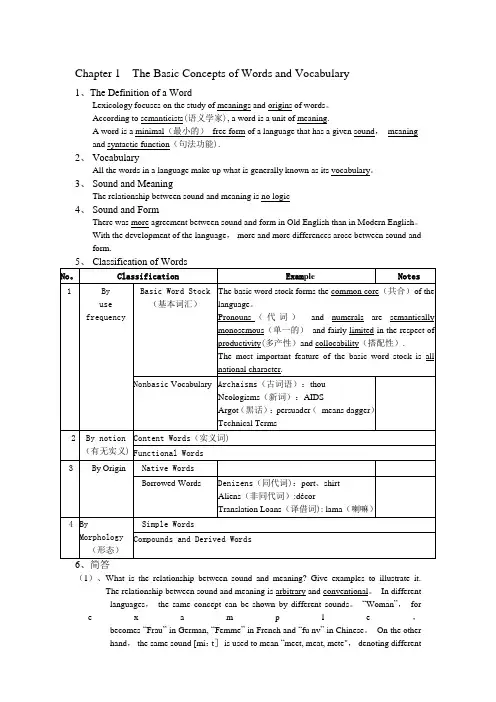
Chapter 1 The Basic Concepts of Words and Vocabulary1、The Definition of a WordLexicology focuses on the study of meanings and origins of words。
According to semanticists(语义学家), a word is a unit of meaning.A word is a minimal(最小的)free form of a language that has a given sound,meaningand syntactic function(句法功能).2、 VocabularyAll the words in a language make up what is generally known as its vocabulary。
3、 Sound and MeaningThe relationship between sound and meaning is no logic4、 Sound and FormThere was more agreement between sound and form in Old English than in Modern English。
With the development of the language,more and more differences arose between sound and form.(1)、What is the relationship between sound and meaning? Give examples to illustrate it.The relationship between sound and meaning is arbitrary and conventional。

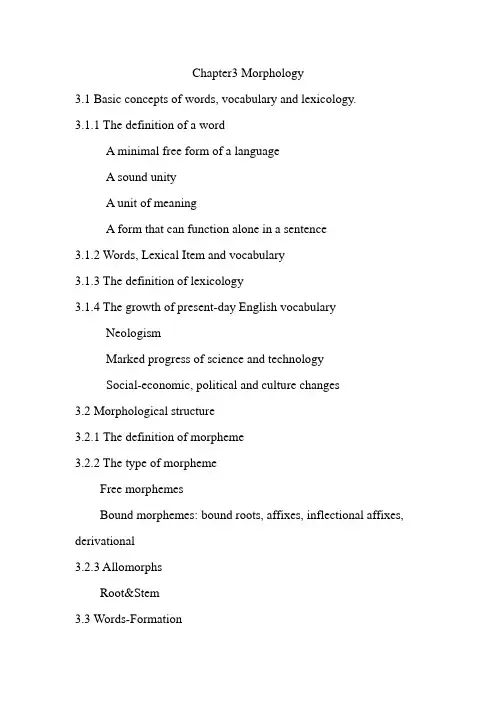
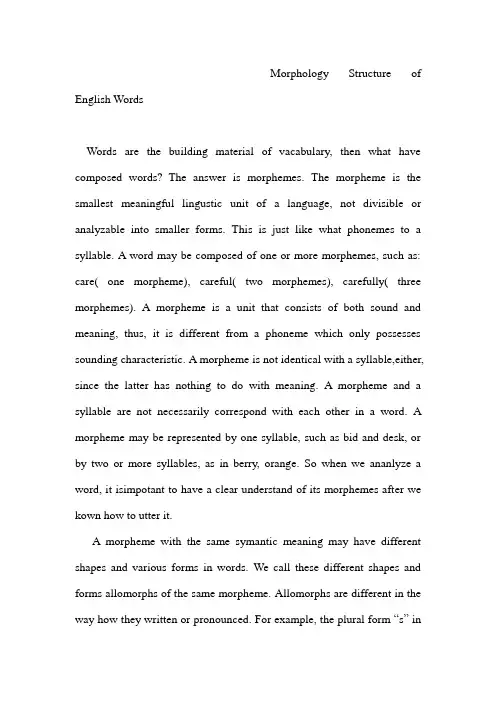
Morphology Structure of English WordsWords are the building material of vacabulary, then what have composed words?The answer is morphemes. The morpheme is the smallest meaningful lingustic unit of a language, not divisible or analyzable into smaller forms. This is just like what phonemes to a syllable. A word may be composed of one or more morphemes, such as: care( one morpheme), careful( two morphemes), carefully( three morphemes). A morpheme is a unit that consists of both sound and meaning, thus, it is different from a phoneme which only possesses sounding characteristic. A morpheme is not identical with a syllable,either, since the latter has nothing to do with meaning. A morpheme and a syllable are not necessarily correspond with each other in a word. A morpheme may be represented by one syllable, such as bid and desk, or by two or more syllables, as in berry, orange. So when we ananlyze a word, it isimpotant to have a clear understand of its morphemes after we kown how to utter it.A morpheme with the same symantic meaning may have different shapes and various forms in words. We call these different shapes and forms allomorphs of the same morpheme. Allomorphs are different in the way how they written or pronounced. For example, the plural form “s” indogs, cats and boxes are different phonological forms: /-s, -tz, -iz/ and the allomorphs –ion/-tion/-ation/-sion. When they form words, they do not differ in meaning but show a littlle differece in spelling depending on the last letter of the preceding word. Since allomorphs show no difference in meaning, it will give us a lot of convenience when we analyze a word.In order to make clear of the construction of words, we need to analyze the basic meaning uint of it-morphemes. Through the details we have above, we have known the difinition of morphemes. Then we should come to the classification of morphemes. Accoding to their degree of independence, morphemes can be divided into free and bound. A free morpheme is one that can be used alone with meaning, playing the role of a word. Namely, a free morpheme is a word in traditional sense. For example, boy, man, red. On the contrary, a bound morpheme can never be used alone. For instance, the past tense morpheme “ed”in words like, look+ed and share+ed. The bound morphemes are inflectional elements and affixes in most cases.We can either divided morphemes into roots and affixes. A root is a stable and main part of a word, and it contains the main meaning of the word. For instance, the root “write”in writes, writing, writed and writinghand. We can easily notice that each word has the a kind of semantical relationship with each other, for they share the basic semantic meaning of write. And roots can be further divided into free roots andbound roots. Free roots are free morphemes which can stand a meaning unit (as a word) alone by itself, such as sun, girl, man. A word consisting of one free root is a simple word. Free roots, just like simple words, belong to the basic word-stock, and play a very important role in forming new words in English. Different from free roots, bound roots in English won’t appear alone to convey meaning. They have to compound with other morphemes to form a meaningful word. Quite a number of roots derived from foreign sources, especially from Greek and Latin, belong to the class of bound morphemes, such as “quen” in words like frequent, consequent, sequent and “ceive” in conceive, receive, deceive. Such roots were once a word in its original language. Yet in modern English, they are no more words and cannot exisit on their own nor can they be used to form new words. But a root, no matter a free one or bound one, is the main meaningful part of a word. Having a good command of roots will be helpful when we endeavour to get the meaning of one new word.Affix has been given the definition that affix is a “collection term for the type of fomative that can be used only when added to another morpheme.” Therefore, affix can be treated as bound morphemes. They may be divided into inflectional and derivational types. The inflectional affix has a fixed number and relatively stable content. Inflectional affixs do not change meaning of the word when they are added to another word, nor do they change the class of that word. Main inflectional affix servesto express such meanings as plurality, tense, and the comparative or superlative degree. The difinition “derivational affix”comes from its function when it originates a new words after been added to a word. Many deriviational affixs have a specific semantic meaning; for instance, -er means the person with some qualities as in words like, teacher, painter, writer. And quite a number of other deriviational affixuform various words. The number of deriviational affix, although limited,is much larger than that of inflectional affixes. And the new kinds of deriviational affix has been cropping out all the time when the old ones drops out of use. The affix may be subdevided into preffix and suffix. Preffids are usually put ahead a word and suffix the opposite. We can group both preffix and suffix from teo aspect. The first one is from the angle of their linguistic origin. Native affixes are those that exisisted in English in the OE period or were formed from OE words, such as un-, il-, re-, over-,- ly, -er and –hood. Foreign affixes came as a part of loan words from foreign countries. The foreign ones were adoppted to make the formation of words more convenient. The second one is their productivity: affixes are called prouctive or living when they can be used to form new words. Those are no longer used to form new words are treated dead and unproductive.The classification of morphemes gives us another criterion when we classify word category, i,e. classification of words on a moephemic level.According to the number and types of morphemes a word contain, we can devide words into simple words derived words and compound words such as green house, forget-me-not and house wife.。
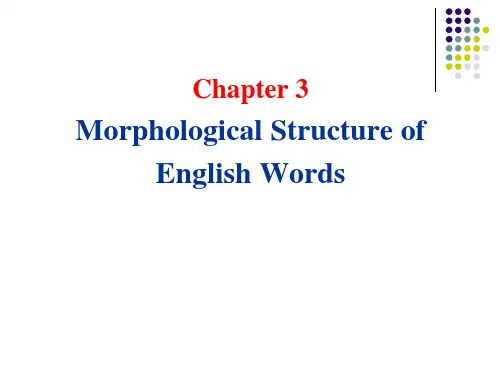
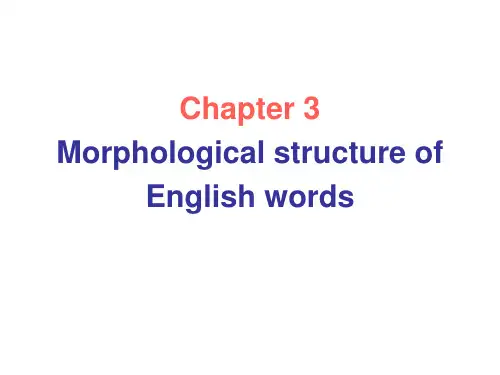
张韵斐著《现代英语词汇学概论》——解析第一部分Chapter Ⅰ英语词汇得概论(Ageneralsurvey ofEnglish vocabu lary)Bloomfield1933中对词得定义就是,每个单词都就是最小得自由词.然而这个定义不够全面,存在着缺陷。
首先,不就是所有得单词都可以独立出现,如the ,a ,my 这些单词单独出现则没有具体意义.另外,Bloomfield得定义侧重在于语法(syntax)却没有涉及到词得意义。
随着词汇学得发展跟完善,人们给词下了较为完整得定义.“词,今指语言组织中得基础单位,能独立运用,具有声音、意义与语法功能。
”(《辞海》1984(上)375页,上海辞书出版社)一种语言中所有得单词汇集起来便构成了该语言得词库。
纵观英语得发展历史,我们可以知道,大多数得英语词汇都就是外来词,它从拉丁语,法语与希腊语等语言中汲取词汇,不断得扩充自己,为己所用.特别就是第二次世界大战之后,英语词汇得到了空前得发展。
现代英语词汇快速发展得原因主要有四方面。
一就是科学技术得快速发展,二就是社会经济得全球化,三就是英语国家得政治与文化变化,最后就是其她文化与语言对英语得强烈影响。
英语词汇就是由各种不同类型得单词组成,而这些单词有着不同得分类标准。
根据词得起源可以分为本族语与外来语;根据使用水平可以分为普通词汇,文学词汇。
口头词汇,俚语以及科学术语.基础语库得基本特征就是具有民族特征,稳定性,构词得能力与搭配能力。
第二部分Chapter Ⅱ到Chapter Ⅳ英语词汇得形态结构与词得构词(Morphologicalstructure of Engli shwords and word—formation)(一)词素(Morphemes)单词就是有词素(morphemes)构成得。
词素即英语语言中有意义得最小单位,同时具有声音与意义.单词可以有一个或一个以上得词素组成。
如:nation就是一个词素,national有nation+al 两个词素。
Chapter 3 Morphology形态学一、本章纲要二、本章重点1.DefinitionsIt is a branch of grammar which studies the internal structure of words and the rules by which words are formed. Two sub-branches: inflectional morphology / lexical or derivational morphology. The former studies inflection and the latter word-formation. 形态学研究单词的内部结构和构词规则,有屈折形态学和词汇形态学两大分支,前者研究语法屈折和语法意义的表达,后者研究单词的构成和同义的表达。
2.Morpheme语素2.1 Morpheme: the smallest meaningful unit of language语素:语言最小的意义单位。
(2004填空)The meaning morphemes convey may be of two kinds: lexical meaning and grammatical meaning. 单词不是语义的最小单位,因为单词可以解析为在意义上更小的意义成分。
语义的最小单位是语素。
语素表达的意义有两种:语法意义和词汇意义。
2.2 Types of morphemes语素的类型2.2.1 Free morphemes自由语素(2005,选择;2006,填空;2007选择)Morphemes, which are independent units of meaning and can be used freely all by themselves or in combination with other morphemes. 自由语素有着完整的语义,它们被称为自由语素是因为它们可以作为单词独立使用,如helpful中的help就是自由词素,因为help可以作为独立的单词来使用。